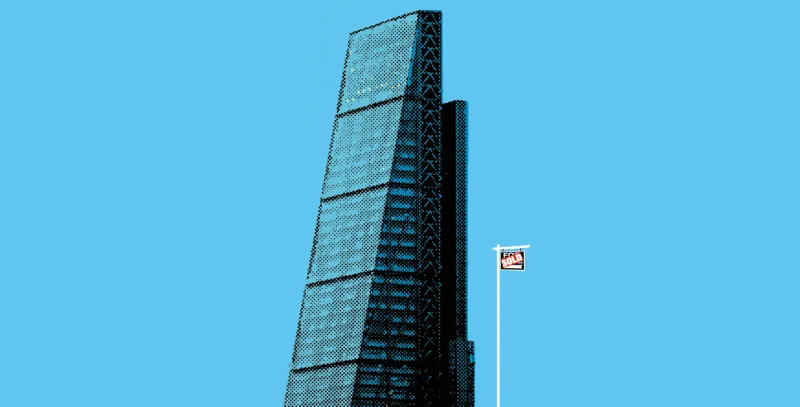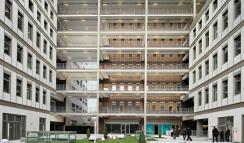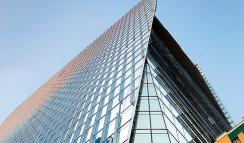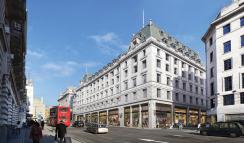
Illustration by Justin Renteria
Michel Vauclair surveys the interior of Berlin’s Sony Center with the appraising eye of a man who knows he can afford it.
“This looks ready for some revamping,” he says, signaling to the mismatched wicker chairs spilling out of restaurants around the dated complex’s central fountain. A Starbucks has for neighbors two family-style German diners, both done out in low lighting and dark wood. The Australian restaurant we’ve chosen — though not for its orange-and-green color scheme — advertises kangaroo burgers on menus shaped like surfboards. You wouldn’t be surprised to find a 1990s Central Perk knockoff in the unit next door. “This food court was probably very nice 15 years ago,” Vauclair remarks. “But even a non-expert would say if we look to the next five years or more, something should be done.”
But Vauclair is an expert. Shortly after our visit, he will sign off on the purchase of the center for €1.1 billion ($1.3 billion).
Since 2008 he has hunted prime European property investments as senior vice president of Oxford Properties Group, the real estate arm of the Ontario Municipal Employees Retirement System, a pension fund created in 1962 for local government employees in Ontario, Canada. With C$85 billion ($66 billion) in net assets and a stellar track record, OMERS is one of the most powerful investment operations worldwide. Ontario’s bus drivers, firefighters, and trash collectors pay in about a third of their pension’s value. The lion’s share comes from investors like Vauclair, and assets like the Sony Center.
In 2010, OMERS directed Oxford Properties to double its investments and curate a property empire beyond North America. The Sony Center is the latest part of a strategy to reach C$5 billion in assets in Europe by 2020.
Vauclair spent two decades managing hotels and sharpening his eye for offensive wicker chairs and the like. To him, updating the food court of a 1.2 million-square-foot multiplex is a bit like refreshing bed linens in a hotel. “This is easiest to spot by all the visitors,” he says. In other words, it’s a good investment. His real mission is to sell office space. At the Australian joint, Vauclair motions to a row of kangaroos cut into the top of the restaurant’s facade. Come February, the office above us will be bustling with Oxford’s own staff, stationed there to seek out the fund’s next big continental buy. “We’ll start with a staff of four to six and grow from there.”
Donald Trump likes to boast that his is “the world’s only global luxury real estate super-brand.” But in the last few decades, real estate’s transition from an entrepreneurial game to an institutional one has only accelerated. Pension funds are quietly buying up trophy real estate in global cities, upping their allocation targets to 10.1 percent on average in 2017, from 8.9 percent in 2013, according to data from advisory firm Hodes Weill & Associates.
“The predominant owners of prime European property are institutional in nature: pension funds, sovereign wealth funds, listed and unlisted vehicles, and insurance companies,” says Andrew Angeli, head of U.K. strategy and research at CBRE Global Investors. “Private investors often have a different rationale for investing in property than institutions.” For example? “Wealth preservation, diversification away from family business, laundering of money, status, and legacy may trump a desire to earn an absolute return.”
OMERS and its peers exist for absolute return. Every basis point on an institutional-scale transaction translates into loonies in Ontario bus drivers’ pockets. But the picture isn’t all rosy. As investors pile into these assets, returns are sliding. Hodes Weill & Associates’ Conviction Index tracks institutions’ view of real estate on a risk-return basis over time. It slid to 4.9 this year from 5.4 in 2016. Market sentiment had declined over the previous 12 months from “moderately optimistic” to “slightly pessimistic,” researchers said. Voluminous capital inflows, global instability, and the specter of rising interest rates loom. London, long the focus of European investment, faces protracted uncertainty with Brexit.
Oxford is not immune to these forces. In 2016 its net return on real estate was 12.4 percent, down from 15.3 percent the previous year. On an institutional time horizon, one year isn’t a trend, but market data suggest they’re not a blip either. Prime rents are falling, Angeli says, and investors are finding it increasingly more difficult to let space. Still, OMERS plans to boost its international real estate holdings from 14.6 percent today to 18 percent by 2020.
If all continues apace, Ontario’s public workers will soon eclipse President Trump in property allocation: Forbes estimates 16 percent of his wealth is in international real estate. Oxford Properties, backed by the OMERS board, thinks it knows how to handle the headwinds. That’s where Berlin comes in.
“The truth is, you need diversification,” Oxford CEO Blake Hutcheson says from Toronto. “If you want to get risk, put all your chips on one square. If you want to stay away from risk, diversify.” When Hutcheson joined in 2010, Oxford’s global portfolio was worth C$16.9 billion. It was 90 percent invested in Canada.
OMERS decreed that Oxford should double its holdings and expand globally. “Canada is synonymous with what’s happening in the oil and gas market,” Hutcheson says. “If we were only domestic today, we wouldn’t have had a fraction of the success that we have had with the diversification strategy over the last seven years.” By 2012, two years into his tenure, Oxford’s portfolio totaled C$21.6 billion. It’s now worth C$47 billion.
“We’ve had a high growth period,” Hutcheson says with Canadian modesty. Oxford’s target is C$60 billion of highly diversified real estate by 2020. Right now, no asset is greater than 5 percent of its book, and no customer is more than 5 percent of its revenue stream. Oxford spreads risk across sectors and asset use, as well as geography. “That makes the business that much stronger,” Hutcheson says. “It de-risks us; it insulates us from shock and it protects us for the decades ahead.”

Hutcheson came to Oxford from a private equity fund in New York, where he targeted distressed global assets for takeover. He was comfortable enough with New York that within a year of joining Oxford, he was signing papers for a stake in the largest private real estate development in U.S. history. Hudson Yards — a project worth upward of $20 billion — is rising above a working railyard on Manhattan’s far west side, the island’s last major plot of undeveloped land.
In Europe, assembling a portfolio worth $20 billion involves a lot more shopping.
That task started in London on the eve of the financial crisis. In 2007, Oxford had acquired a 250-year ground lease in a joint venture with the real estate arm of UBS to develop Watermark Place in the City of London. The C$500 million project would transform Mondial House, a bombproof telephone exchange commissioned by the post office in the 1970s.
By 2008, the London commercial property market lay in tatters. Rents had fallen more than a third since 2007 and vacancies had risen. Oxford staged a coup, signing off on the biggest single letting of a speculatively built office in the City of London’s history, snaring Japanese bank Nomura and its 4,000-person staff with a 20-year lease on which it did not have to pay rent for six years. To this day, it is one of the biggest single rental deals in the Square Mile.
Watermark Place, which opened in 2009, is a pageantry of modernism. It incorporated one third of the original structure, ventilated facades, and a 20,000-square-foot roof terrace overlooking the River Thames. At the time, Paul Brundage, senior managing director for Europe at Oxford Properties, told the Financial Times his firm was pleased with the deal, especially with signing a single long-term tenant.
“It was a frightening period of time there for sure,” Hutcheson remembers. Yet Oxford, via Nomura, actually benefited from the collapse of Lehman Brothers by getting a few extra bums on seats, the CEO adds. “Because of Lehman there was a breakout of people joining Nomura.”
Through the Watermark building, Hutcheson says, Oxford learned whom it could rely on among professionals and intermediaries. In 2010 the fund exercised its right to buy UBS out of Watermark. Then it let loose. “We were quite aggressive by local standards,” Hutcheson says. “The timing was quite extraordinary. We added seven assets within three years — that’s C$7 billion worth of activity. We did extraordinarily well in terms of buying long-term assets and capitalizing on mass appreciation.”
Among them: Green Park, a business park in Reading, which it bought for €473 million ($661 million) in 2011 and sold to Singapore’s Mapletree Investments in 2016 for around €718 million, a 51 percent markup; St. Martin’s Court and King Edward Court on Paternoster Square, a mixed-use retail and restaurant property next to St. Paul’s Cathedral, acquired for €137 million in 2012 and €279 million in 2013, respectively — then sold for a combined €472 million in December 2016 for a markup of 14 percent; and the Royal Exchange, a luxury retail space bought for £86.5 million (then $151 million) in 2013, which it still holds. While other institutional investors stood on the sidelines, marveling at the bottom going out of the market, Oxford was cleaning up.
Hutcheson grew up talking real estate around the family dinner table in the small town of Huntsville, Ontario, a community of 19,816 just north of Toronto. His grandfather made money on lumber and invested it in land and by developing small properties. Hutcheson’s father was a serial entrepreneur, building roads, farming, and peddling Christmas trees.
Hutcheson earned a B.A. in political science from the University of Western Ontario. He chalked up a graduate diploma in international relations from the London School of Economics and a master’s in real estate development from Columbia University in New York. But it didn’t take a roster of international qualifications for him to know that London in 2009 was still a safe bet.
“Supply and demand is the simple way to look at real estate,” he says. “Supply was in check because you could only build so much into the system. We wanted as much as we could get our checkbooks in front of.”
Oxford Properties is “Warren Buffett-esque,” in his view: “We want great assets at good prices as opposed to good assets at great prices. We are prepared to invest in quality. We’re a long-term pension fund with long-term liabilities, so much of this real estate we will hold through multiple cycles in the future.”
City planners like institutional investors. They tend to have deeper and more stable capital pools than private investors and asset managers, hold real estate through cycles of boom and bust, and, to keep their tenants happy, tend to be active managers of the spaces in which they invest. But as London property heats up, long-term investors are increasingly getting speculative offers that are too good to turn down from Asian investors. Big institutional money has to go somewhere — so investors try to get ahead in new markets, or shell out on huge building projects that potentially offer higher returns.
Take the Leadenhall Building, the wedge-shaped skyscraper nicknamed the Cheesegrater, in the City of London. Oxford kick-started its development in 2010, after it had stalled during the financial crisis. It shared the £350 million cost in a joint venture with British Land, one of the U.K.’s largest developers, in a deal hailed as a vote of confidence in the City.
One year later global insurer Aon announced that it would take ten of the larger floors of the building for its headquarters, amounting to a third of the space. It took an option on a further 85,000 square feet. “It’s not a miracle,” Vauclair says, reflecting on Aon’s decision. “We knew [the Leadenhall Building] was not only in the City but in the heart of the insurance district, next to Lloyds.”

When the building opened in 2014, the average annual total return on City office properties was 6.9 percent, compared to 11.2 percent in London’s West End and 9.6 percent in the middle district of Bloomsbury and Holborn. Oxford, happy to leave the London market to its own devices, pressed on with its European expansion. In September 2014 it made its first Paris purchase with a 273,000-square-foot building on Rue Blanche, central Paris, for €264 million. The head office of Réseau Ferré de France, the state-controlled railway network, at 92 Avenue de France, followed for €240 million in January 2015. Then it bought PariSquare, a 260,000-square-foot office campus on the site of a former multi-story parking garage, for €250 million in October 2015. Oxford still holds these assets.
By this time the Leadenhall Building in London had been completed and was 70 percent let. Things were looking up. Prime City rents were up 10 percent in the third quarter of 2015, according to figures from JLL, because of a shortage of space. Oxford moved its London office into the 28th and 29th floors, and leased the 41st floor to FM Global for a reputed £83.50 per square foot — a City record.
“We thought we would be there for decades,” Hutcheson says. Then came that offer he couldn’t refuse.
In March 2017 a Chinese property magnate’s firm, CC Land, surprised Oxford with a speculative bid for the Leadenhall Building. Offering more than £1.15 billion in May, CC Land paid 26 percent beyond the £915 million valuation of six months earlier. Everyone has a price, and that, apparently, met Oxford’s. “When that came over the bow, we thought we could redeploy that capital at higher yields and satisfy the demands of our pension fund,” Hutcheson says. They sold. So did British Land. At the time, the transaction was the second-most valuable U.K. building sale in history, topped only by the Qatari sovereign wealth fund’s 2014 purchase of HSBC tower in Canary Wharf for £1.18 billion.
It was also the largest purchase of a single building in the U.K. by a Chinese buyer. The weakening of the pound after Brexit has opened the floodgates to Hong Kong and Chinese investors for whom London real estate is up to 20 percent cheaper than before the referendum. In July the Walkie Talkie, another distinctive London landmark, sold for £1.3 billion after an unsolicited offer from Lee Kum Kee, a sauces and condiments vendor from Hong Kong. Less than a decade since the financial crisis, the deal broke all previous records to become the biggest single sale in City history.
The City of London as it stands today is largely the work of one man. For 29 years, from 1985 to 2014, Peter Rees was the chief planning officer for this small borough in the center of the capital. He took the post just before the “big bang,” the sudden deregulation of financial markets, in 1986. Overnight, London switched from face-to-face share dealing to electronic trading and became a financial center to rival New York.
International banks flocked to get a piece of the City. “It takes an outsider to see how wonderful London is,” Rees says from his office at University College London, where he now teaches. When the big bang happened, Rees fended off planners who wanted to accommodate this influx of cash by turning the borough into another monument of glass and steel like Canary Wharf. “I said, ‘No, we should be more like the West End. If the young people want to be there, that’s where the business will want to be.’” As a planner, Rees wanted to achieve “vibrant, active places,” he says. “That’s to all our benefit, including the investors’.” He protected pubs from closure and defended nightclubs’ licenses, encouraging mixed-use buildings so employees would stay on drinking after work.
With its cluster of skyscrapers, the City of London has a big-business reputation. In fact, roughly 80 percent of companies occupy less than 10,000 square feet of space individually. It is the capital of insurance, an industry comprising smaller firms nearby one another. Rees shaped the City as an attractive place for these specialists to congregate. Insurance companies “have to attract the brightest minds around the world, and to do that it has to be a fun place,” he says. “That’s what made the difference.”
Brexit, far from dampening spirits, has made City real estate more competitive. “It’s a head scratcher for domestic investors,” says CBRE’s Angeli. “Brexit is casting a pretty dark cloud. Prime rents are falling and we’re having increasingly more difficulty letting up space. Even in that environment you have multiple Chinese investors coming in at low yields and high prices per square foot to acquire property. If you’re an owner like Oxford, it’s a great time to be selling.”
Angeli says 11 assets valued at more than £100 million have come to market or will soon, their sellers hoping to capitalize on momentum. “Half of Gresham Street is for sale,” he remarks of a street near St. Paul’s Cathedral in the Square Mile. “When you have so much stock hitting the market, [sellers] may be too late.”
Hutcheson and Oxford aren’t spooked. “I still think that London is arguably the best city in the world,” he declares, noting that Oxford is always in the market for opportunities.
The trick is finding them in a hot market, like London’s. Oxford is more likely to make an Irish goodbye and start another party in a different city. “As investors, you ask yourself what you are great at and how you can get in front of a trend that you believe will be high growth, given limited resources. Often you can get harmony with a mixed-use project that sprinkles a little bit of living, a little bit of retail, a little bit of office that is very involved with the new generation in terms of how they want to live, work, and play.”
Two hundred feet above where Vauclair sits sipping still water, sunlight filters through 105 tons of thick safety glass and into the Sony Center. An umbrella of self-cleaning Teflon-coated fabric gives the impression of sails powering a turbine. At night these sails are illuminated by evolving colors in a 21-second sequence designed by the lighting artist Yann Kersalé.
Beneath this canopy, Oxford found all the sprinkles of mixed-use buildings it most desires. A little bit of living from the 67 apartments. A little bit of retail from Legoland and CineStar. And a little bit of office space occupied by Deutsche Bahn, Facebook, Sanofi, Sony, the state of Berlin, and WeWork. The center is 97 percent full. The prime location, right in the heart of Berlin, hints at Oxford’s playbook.
The Sony Center, designed by Helmut Jahn and completed in 2000, came in over budget at €750 million. It was sold to South Korea’s state-run National Pension Service for €585 million in 2010. By the time the Koreans put it on the market in July, it had doubled in value.
Oxford reportedly fought off five other bidders to buy the Sony Center for €1.1 billion this summer. “We decided to go deep and strong,” Vauclair says. The fund had become an expert. It spent two years hunting for the best city in Germany, and after finding it, searched for the best street in Berlin. “Real estate is a local business,” Hutcheson explains. “We believe in the global trend of net migration to cities, so our strategy is increasingly city-centric, but that trend will not be universal. We think it will be much more accelerated in certain cities in the world. That’s been a big part of the sieve that we overlay on the cities we invest in.”

Berlin caught in Oxford’s sieve. Between 40,000 and 50,000 young people move to the German capital every year to work for tech companies and revel in the city’s green spaces, cheap accommodation, and great nightlife. Most importantly, it has lots of open space for developing buildings on the scale of the Leadenhall in London, or even whole communities on the scale of Hudson Yards in New York. “If you have the potential to develop, the earning potential is far greater,” Hutcheson says, though he believes there’s a time and a place for buying. “You can’t always access great development projects. They are risky. So you look at value enhancement through retrofitting.”
Vauclair already has an eye on the Bahn Tower, which Oxford acquired with the Sony Center. This 26-story building on the corner of Potsdamer Platz houses national railway company Deutsche Bahn’s headquarters, at least until the lease comes up for renewal in 2024. “They may decide to leave or to stay; it’s too early to ask,” Vauclair says. “If they were to leave, you could create the office building of the future.”
Suddenly the appraising hotelier is back, narrating potential floor plans, color schemes, and adjustable desks to draw the young workers already flocking to Berlin. “We need to think about selling,” he says. “Once we have boots on the ground here, our next investment in Germany will likely be in Berlin. We see Berlin as a city where we can easily go from €1.1 billion to €1.5 billion or €2 billion because the city is large enough.”
Hutcheson concurs: “When we move into a new market we are very prescribed, very thoughtful. We move slowly until we get excited. And when we load our gun, we load our gun in a serious way.”
Photo credit: Photo 1 and 2: PariSquare is Oxford Properties’ third acquisition in Paris. It bought the 260,000-square-foot office campus and former multi-story parking garage for €250 million in October 2015; Photo 3: Oxford Properties acquired St. James’s Market, on the site of the historic market near Regent Street, for €412.9 million in May 2013; All photos Courtesy of Oxford Properties.





